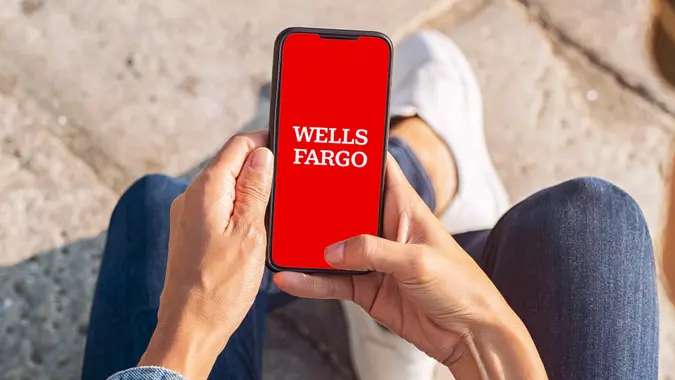What Is a Savings Account and How Does It Work?

Commitment to Our Readers
GOBankingRates' editorial team is committed to bringing you unbiased reviews and information. We use data-driven methodologies to evaluate financial products and services - our reviews and ratings are not influenced by advertisers. You can read more about our editorial guidelines and our products and services review methodology.

20 Years
Helping You Live Richer

Reviewed
by Experts

Trusted by
Millions of Readers
A savings account stores your money for a later date, such as an emergency fund or a savings for a down payment.
Unlike a checking account, which is designed for frequent withdrawals and direct purchases, the purpose of a savings account is to put money aside for the future and earn interest on the account balance.
How Savings Accounts Work
A savings account works by growing your deposits over time with the interest you earn. When you fund a savings account, the bank or financial institution lends your money to other people and charges them interest. In return, the financial institution pays you interest.
In the unlikely event that the bank goes under, your money is protected. Savings accounts in the United States are insured up to $250,000 by the Federal Deposit Insurance Corp. or the National Credit Union Administration.
Savings accounts were previously long beholden to withdrawal limits. That was largely discontinued in 2020 — though some banks may still charge you for excessive withdrawals.
Pros of Having a Savings Account
- You can set savings goals to build an emergency fund, set aside money for a specific purchase, etc. Many banks make the process fun with interactive tools that display your progress.
- You can instantly transfer funds into your checking account to pay credit cards, write checks, swipe your debit card, etc. If you ever want cash, you can hop over to the bank or a qualifying ATM whenever you like.
- FDIC and NCUA insurance keeps your money safe. If your financial institution offers this protection, your deposits are covered up to $250,000 per account holder per financial institution.

Cons of Having a Savings Account
- Your interest rate isn’t always locked in. Unless you have a CD, your bank has the power to lower (or raise) interest rates at any time. To get the most out of a savings account, you might have to move your money around to get the best rate.
- Your money isn’t always locked away. Unless you sign up for a CD, you can transfer your money out at any time. If you have trouble leaving your savings alone, this can make it difficult for your money to grow.
- Some banks have minimum balance requirements. Once you reach your savings goal and transfer the money out of your account, you might have to close the account or pay fees if you don’t meet the minimum.
Types of Savings Accounts
Generally speaking, there are three main types of savings accounts:
- Regular deposit accounts, which offer basic features and accessibility already discussed
- Money market accounts
- Certificates of deposit.
With different rules and investment options, these accounts can offer higher returns without putting your money at risk. Other savings accounts offer tax benefits, and most include FDIC or NCUA insurance protection. Here are some of your options.
High-Yield Savings Accounts
A high-yield savings account pays a higher interest rate than a basic savings account. Many online-only banks offer high-yield accounts. Some of the biggest banks in the nation have an APY of just 0.01%. Because they don’t have the same overhead that brick-and-mortar banks do, online-only banks may share their savings with account holders by offering greater interest payouts.
CDs
A certificate of deposit is a savings account with more restrictive withdrawal rules. In short, you must promise to not withdraw your money from the bank for a specific amount of time. In exchange, you’ll receive a higher-than-normal annual percentage yield. If you decide you want your money before your CD terms, you’ll incur penalties. In other words, CDs are not suitable for funds you might need in an emergency.
Money Market Accounts
A money market account is a hybrid savings and checking account. You can withdraw your funds by check or by electronic or telephone transactions. Some also offer a debit card.
A money market account pays interest, but often not at as high a rate as high-yield savings accounts might offer. These are consumer deposit accounts and not investment accounts.
Specialized Savings Accounts
Specialized accounts are a boon for many situations, whether you’re saving for retirement, a medical emergency, or more. You can also open kid-focused savings accounts, such as those that help you prepare for their education or simply help them to learn how to handle money.
A common specialized savings account is called a health savings account, or HSA. If you are in an eligible high-deductible health plan, health savings accounts allow you to contribute up to a specific amount per year and pay for qualified medical expenses using pretax dollars. Moreover, unused funds can carry over to the next year. HSAs should also not be confused with flexible spending accounts, which are employer-controlled.
How To Choose the Right Savings Account
When looking for the perfect savings account, there are a few boxes you should strive to check:
- Examine interest rates. There are so many great savings accounts that award competitive APY. If your money isn’t in one of these accounts, you’re effectively lighting dollar bills on fire.
- Weigh fees and minimum balances. Even if you’re earning competitive interest for your account balance, you can lose more money than you earn if you’re incurring fees. Most accounts will waive these fees after certain monthly activity, such as maintaining a specific balance or using your debit card a specific number of times.
- Find acceptable account access. Again, some of the highest-APY savings accounts are offered by online-only banks. If you like doing your banking in-person, you may prefer a bank with brick-and-mortar locations, instead.
- Research bank reputation. Handing your money over to someone else isn’t a decision to take lightly. Do your homework to ensure you’re handing your savings over to a trustworthy bank or credit union.
Tips for Making the Most from Your Savings Account
Savings accounts are typically very easy to use. But there’s still a strategy to wringing the most value from them as you can.
First, you should regularly contribute to the account to grow your balance. The more you contribute, the faster you’ll reach your elusive financial goals–and the more APY you’ll earn.
One strategy you might consider is automatic savings deposits right from your paycheck. Financial author and columnist Suze Orman recommends this approach. Orman says it doesn’t matter whether you contribute $10 per month or $250 or $1,000, but she insists that you contribute automatically. She considers this an excellent “set it and forget it” approach for reaching savings goals. If the money is out of sight, it’s out of mind — and less of a temptation to spend.
You should also keep on top of the latest high-yield savings account rates. The amount of interest you’ll earn on a basic savings account varies widely by financial institution. It could be worth moving your money from bank to bank to take advantage of the best offers.
How to Open a Savings Account
Here’s how to start saving:
- Find a financial institution. Do your research to find the best interest rates, the lowest fees and balance requirements that meet your financial goals.
- Gather your personal information. To open a new account you’ll usually need your social security number, contact information and bank account information if you’re transferring money over.
- Apply for the account. Submit your application and make sure all of your personal information is correct.
- Fund the account. Transfer money into your new account
Explore More on Savings Accounts
- Best Savings Accounts
- Types of Savings Accounts: Where Is the Best Place To Put Your Savings?
- How To Open a Savings Account in 4 Steps
- Checking vs. Savings Accounts: What’s the Difference?
- How Much Should I Have in Savings?
- 7 Strategies To Grow Your Savings Account to $1 Million
Will Healy, Daria Uhlig and Jami Farkas contributed to the reporting for this article.
Our in-house research team and on-site financial experts work together to create content that’s accurate, impartial, and up to date. We fact-check every single statistic, quote and fact using trusted primary resources to make sure the information we provide is correct. You can learn more about GOBankingRates’ processes and standards in our editorial policy.
- MyCreditUnion.gov. "Power of Dividends."
- Investor.gov. "Compound Interest Calculator."
 Written by
Written by  Edited by
Edited by 

























